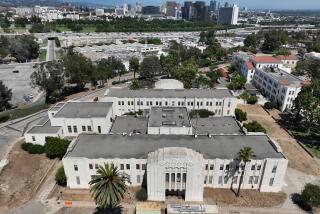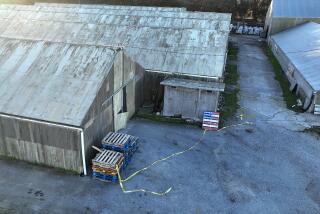Intensive Care Demanded in Expansion of Hoag Hospital : Planning: Neighbors and doctors worry about increased traffic, decreased open space, proximity to an earthquake fault and gas from wells.
- Share via
NEWPORT BEACH — It has been decades since Hoag Hospital was a tiny, 75-bed community health center atop a hill here, but many of its patients and financial benefactors still see it as the local neighborhood hospital.
Today, Hoag is poised to lose that hospital-next-door image, but the change is not likely to come without a fight.
Last week, the hospital’s massive expansion plans won unanimous City Council approval, setting the stage for Hoag to become over the next 25 years a premier regional medical facility, with state-of-the-art services and larger buildings--but also increased traffic and decreased open space.
Many residents look forward to the cutting-edge care Hoag will offer, and hospital officials are pleased at the outpouring of community support for the nonprofit facility, which relies on residents for funding.
But while Hoag officials cleared a major hurdle in winning council approval, outstanding issues remain that could thwart their plans.
Neighbors are concerned that the plan calls for building too close to homes, and state agencies are worried about the proposed new buildings’ proximity to the Newport-Inglewood Fault and subterranean gas deposits.
As they did at several City Council hearings over six months, foes speak of challenging Hoag at upcoming state Coastal Commission hearings for changes to preserve views, open space and a quiet neighborhood before the plan wins final approval. There is also talk of possible court battles.
“I don’t think anyone should think Hoag Hospital is going to run away with this just because they have (city) approval,” said former Mayor Jackie Heather, co-chairwoman of Hoag 2010, a community group that supported the hospital during recent public hearings.
The Coastal Commission, the Army Corps of Engineers and the three state agencies that have questioned the proposal--the Environmental Protection Agency, the Regional Water Quality Control Board and the South Coast Air Quality Management District--will all play some role in ensuring that the site is safe for construction, said Patricia Temple, Newport Beach’s advance planner, who has headed the Hoag project for the city.
One of the main concerns of these agencies are the gases beneath the site, believed to have accumulated from defunct oil wells, including a large deposit of hydrogen sulfide. Since the 1970s, the city has overseen a program in which the gas is collected through an underground pipe system, then burned off in a towering flame. There are also concentrations of benzene, a known carcinogen, and methane, which can be explosive in high quantities.
Hoag plans to continue collecting the gas through the existing underground pipes but will also use some of it to fire hospital burners. Hoag also plans to line the earth with a plastic-like tarp to prevent the gases from seeping into buildings.
Hospital officials will need to prove that it has satisfied all safety conditions required by state agencies before the city can issue building permits, according to Temple and representatives of the agencies.
“If they comply, they build,” Temple said. “If they don’t, they don’t.”
But even if they comply with state regulations, some residents question the integrity of the hospital for going forward with the plans, despite some opposition from in the community.
“I don’t think they can be a premier medical facility, given the location of their expansion,” said Dr. Jan Vandersloot, a Newport Beach resident on staff at Hoag who has been at the forefront of the the gas and fault issues.
“I don’t know anyone that could be so presumptuous to build on an earthquake fault and gas mitigation site,” Vandersloot said.
Hoag’s vision for the next 25 years is to offer cutting-edge care focusing on what one supporter called “hassle-free” outpatient services and procedures--including surgery, in some case--in fields such as optometry and gynecology without the patient being burdened by a lengthy, costly hospital stay.
Likewise, the hospital plans to be at the forefront of cancer and cardiac care, two areas where Hoag already uses the latest technologies and experimental practices. Hoag hopes its imaging and radiology services will also become flagship departments.
Jim Dale, co-chairman of Hoag 2010 and president of the 552 Club, which raises funds for the nonprofit hospital, said: “People will be able to drive to the door practically, get their services and drive home. . . . If people can drive five to 10 minutes from home rather than 20 to 30 minutes on the freeway to get their treatment, that reduces their stress level. And if the stress is gone, the healing’s going to occur a lot faster.
To build such advanced services, hospital officials say they need to expand their patient base. Hoag hopes to reach beyond Newport Beach boundaries for patients to make Hoag a truly regional facility.
“The master plan allows us to be able to expand in a reasonable capacity to meet the future needs of the community,” said Peter Foulke, senior vice president at Hoag. “The little 75-bed hospital that Hoag started out as is definitely, I think, something that will not exist.”
A movement away from family doctors and local hospitals to larger medical centers has been a mainstay of the health care industry for the past decade. Many in the community believe that Hoag’s growth will only help the hospital in its ability to serve Newport Beach residents.
“Hoag’s grown and matured,” said former mayor Heather, a Newport Beach resident for 34 years. “When we first came here, people always went somewhere else to get their medical care. . . . They always got second opinions somewhere else, like in Los Angeles. That was always disturbing.
“It’s very reassuring that Hoag is going to be there and is going to offer this superior care,” she said.
While most of Hoag’s neighbors agree that there is a need for superior care, many argue that it should not come at the expense of their neighborhood. Hoag, they say, has not been the best of neighbors in the past, so they want the new buildings constructed farther from their homes.
In their pleas for an alternative expansion plan, these neighbors point to city-commissioned traffic studies showing 8,000 more trips a day to Hoag and to sketches of buildings 54 feet from their homes. They say existing noise from delivery trucks and emergency sirens is already excessive.
Some of the residents who fought the hospital for the past six months are considering lawsuits to stop the development, and others plan to challenge the hospital all over again at Coastal Commission hearings.
“I don’t know anyone who wanted (an expansion) plan turned down,” said John Chamberlin, who lives next to Hoag and like dozens of his neighbors sat through hours of public hearings on the master plan and raised money to hire architects and planners to devise alternative proposals. “The issue has always been a good plan versus a bad plan.”
Most opponents call for a requirement that Hoag’s master plan, which is a vague sketch of possible future development, be more detailed.
“The city got caught in an inability to chisel out a full plan,” Chamberlin said. “I think no one can go to bed at night and know what has been granted. . . . (Is Hoag) going to stir up things with the neighbors 18 years down the road, who could not possibly believe that what they’re building was the intent of the decision last week?”
More to Read
Sign up for Essential California
The most important California stories and recommendations in your inbox every morning.
You may occasionally receive promotional content from the Los Angeles Times.














![Vista, California-Apri 2, 2025-Hours after undergoing dental surgery a 9-year-old girl was found unresponsive in her home, officials are investigating what caused her death. On March 18, Silvanna Moreno was placed under anesthesia for a dental surgery at Dreamtime Dentistry, a dental facility that "strive[s] to be the premier office for sedation dentistry in Vitsa, CA. (Google Maps)](https://ca-times.brightspotcdn.com/dims4/default/07a58b2/2147483647/strip/true/crop/2016x1344+29+0/resize/840x560!/quality/75/?url=https%3A%2F%2Fcalifornia-times-brightspot.s3.amazonaws.com%2F78%2Ffd%2F9bbf9b62489fa209f9c67df2e472%2Fla-me-dreamtime-dentist-01.jpg)